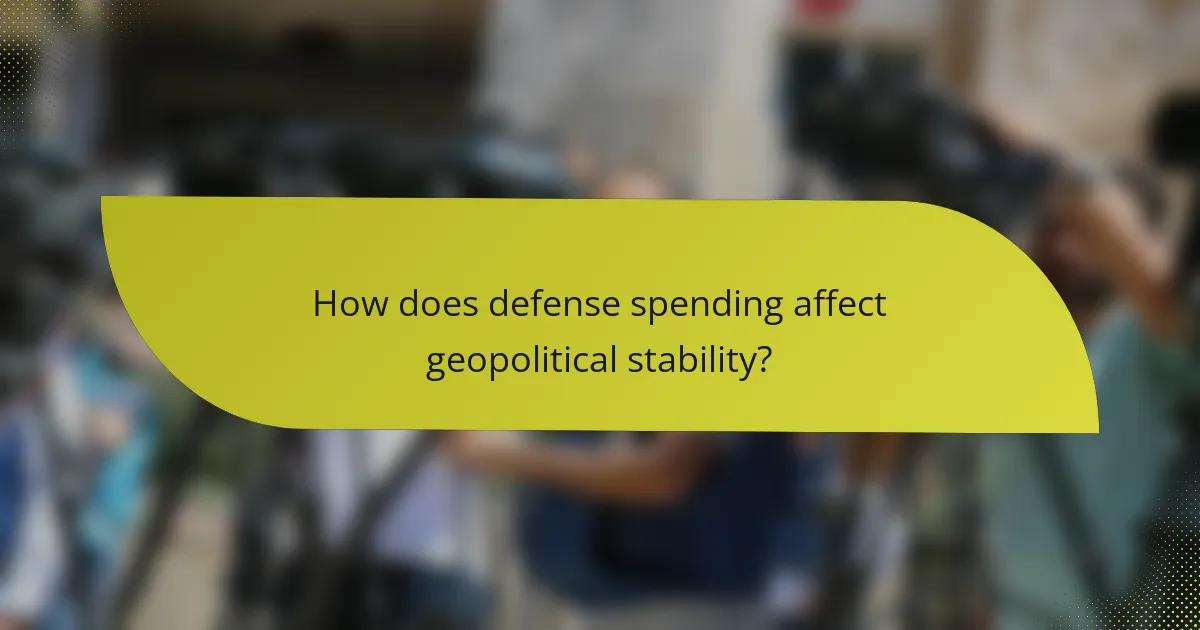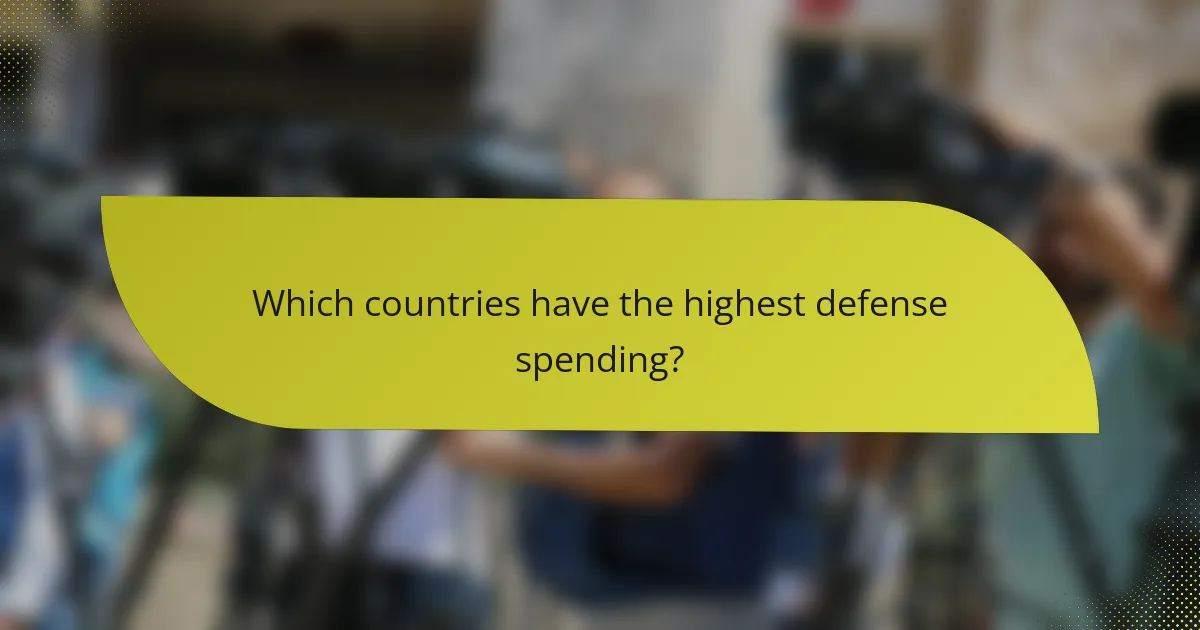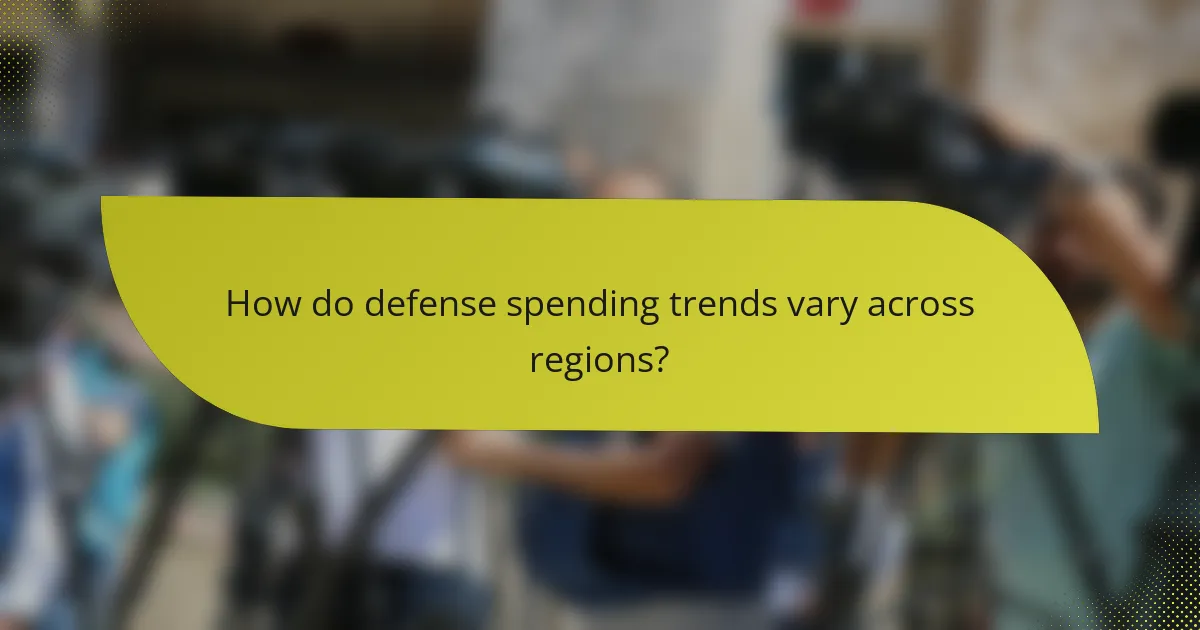Defense spending plays a crucial role in shaping geopolitical stability and security by bolstering a nation’s military capabilities and affecting international relations. While increased defense budgets can foster a sense of security, they may also heighten tensions if viewed as aggressive posturing by neighboring countries. Understanding the dynamics of defense expenditures is essential for analyzing how nations navigate complex security landscapes and prioritize their military strategies.

How does defense spending affect geopolitical stability?
Defense spending significantly impacts geopolitical stability by enhancing a nation’s military strength and influencing its relationships with other countries. Increased investment in defense can lead to a more secure environment but may also escalate tensions if perceived as aggressive by neighboring states.
Increased military capabilities
Higher defense spending typically translates into improved military capabilities, including advanced technology, better training, and more personnel. Countries that allocate substantial budgets to their armed forces can develop cutting-edge weaponry and maintain a ready-to-deploy military force.
For example, nations like the United States and China have invested heavily in modernizing their fleets and ground forces, which has raised their global military profiles. This investment can deter potential conflicts but may also provoke arms races in volatile regions.
Deterrence against aggression
Robust defense spending serves as a deterrent against potential aggressors by signaling a nation’s readiness to defend itself. When a country demonstrates military strength, it may discourage hostile actions from adversaries who fear retaliation.
For instance, NATO’s collective defense posture, supported by significant military expenditures from member states, aims to deter aggression from non-member countries. This approach has historically contributed to stability in Europe, particularly during tense periods.
Impact on international relations
Defense spending can shape international relations by influencing alliances and partnerships. Countries with high military expenditures often seek to strengthen ties with others that share similar security interests, leading to strategic alliances.
Conversely, nations that feel threatened by another’s military buildup may respond with their own increases in defense budgets, potentially leading to a cycle of escalation. For example, the arms race in South Asia between India and Pakistan illustrates how defense spending can strain diplomatic relations and heighten regional tensions.

What are the key factors influencing defense budgets?
Defense budgets are primarily influenced by economic conditions, political priorities, and security threats. Understanding these factors helps in analyzing how countries allocate resources for their military and defense strategies.
Economic conditions
Economic conditions play a crucial role in shaping defense budgets. When a country’s economy is strong, it is more likely to increase military spending to enhance its capabilities. Conversely, during economic downturns, defense budgets may face cuts as governments prioritize social spending and debt reduction.
For instance, nations with GDP growth rates above 3% often allocate a higher percentage of their budget to defense, while those in recession may reduce defense spending by 5-10%. This relationship highlights the importance of economic health in determining military funding.
Political priorities
Political priorities significantly influence defense budgets, as governments align military spending with their strategic objectives and ideological beliefs. A government focused on national security may prioritize defense funding, while one emphasizing diplomacy might allocate less to military expenditures.
For example, a country facing internal unrest may increase its defense budget to maintain order, while a government pursuing international cooperation might seek to reduce military spending in favor of foreign aid. Political shifts can lead to rapid changes in defense allocations, reflecting the current administration’s stance on military engagement.
Security threats
Security threats are a primary driver of defense budgets, as nations adjust spending based on perceived risks. Countries facing immediate threats, such as regional conflicts or terrorism, often increase their military budgets to bolster defense capabilities.
For instance, nations in volatile regions may see defense spending rise significantly, sometimes by 15-20%, to address border security and counter-terrorism efforts. In contrast, countries with stable environments may maintain or even reduce their defense budgets, reflecting a lower perceived need for military investment.

Which countries have the highest defense spending?
The countries with the highest defense spending are primarily the United States, China, and Russia. These nations allocate substantial portions of their budgets to military capabilities, reflecting their strategic priorities and geopolitical ambitions.
United States
The United States consistently leads the world in defense spending, with expenditures often exceeding $700 billion annually. This significant budget supports a vast array of military operations, advanced technology development, and a global military presence.
Key areas of investment include cybersecurity, naval power, and air force capabilities. The U.S. defense budget is influenced by various factors, including international commitments, emerging threats, and domestic political considerations.
China
China ranks second in defense spending, with estimates around $250 billion to $300 billion per year. This investment is part of China’s broader strategy to modernize its military and assert its influence in the Asia-Pacific region.
China focuses on enhancing its naval capabilities, missile technology, and cyber warfare. The increasing budget reflects its ambitions to challenge U.S. dominance and secure its territorial claims, particularly in the South China Sea.
Russia
Russia’s defense spending is approximately $70 billion to $90 billion annually, reflecting its focus on military modernization and regional influence. The budget supports a range of military initiatives, including nuclear capabilities and conventional forces.
Russia’s military expenditures are often driven by geopolitical tensions, particularly with NATO and neighboring countries. The emphasis on military readiness and modernization is evident in its recent military engagements and strategic posturing.

How does defense spending correlate with national security?
Defense spending is closely linked to national security as it directly influences a country’s ability to protect itself and respond to threats. Increased investment in defense can enhance military capabilities, deter aggression, and promote stability both domestically and internationally.
Investment in technology
Investment in advanced technology is crucial for modern defense strategies. Countries that allocate significant portions of their defense budgets to research and development can enhance their military effectiveness through innovations such as cybersecurity, drones, and artificial intelligence.
For example, nations like the United States and Israel have prioritized technology investments, resulting in superior military capabilities that can respond swiftly to emerging threats. This focus on technology not only improves defense but also fosters economic growth through the development of high-tech industries.
Military readiness
Military readiness refers to the preparedness of armed forces to respond to conflicts and emergencies. Adequate defense spending ensures that military personnel are well-trained, equipped, and capable of executing missions effectively.
Countries with higher defense budgets typically maintain better-trained forces, advanced equipment, and sufficient supplies. For instance, NATO countries are encouraged to spend at least 2% of their GDP on defense to ensure collective readiness and deterrence against potential threats.
Alliances and partnerships
Defense spending plays a vital role in forming and maintaining alliances and partnerships. Countries that invest in their military capabilities can contribute more effectively to joint operations and international security initiatives.
For example, nations that meet NATO’s defense spending guidelines strengthen their commitments to collective defense, enhancing geopolitical stability. Collaborative defense efforts, such as joint exercises and shared intelligence, are more feasible when member states invest adequately in their military forces.

What are the implications of defense spending on global security?
Defense spending significantly influences global security by shaping military capabilities and international relations. Increased military budgets can lead to enhanced deterrence but may also escalate tensions and provoke arms races among nations.
Arms race dynamics
Defense spending often triggers arms races, where countries increase their military expenditures in response to perceived threats from rivals. This competitive buildup can destabilize regions, as nations prioritize military capabilities over diplomatic solutions.
For example, in Eastern Europe, heightened defense budgets among NATO members and Russia have led to a cycle of military enhancements, increasing the risk of miscalculations and conflicts. Countries may feel compelled to invest heavily in advanced weaponry, which can divert resources from other critical areas like education and healthcare.
Regional conflicts
High defense spending can exacerbate existing regional conflicts by providing nations with the means to engage in military confrontations. Increased military capabilities may embolden states to pursue aggressive policies, leading to escalated tensions and potential warfare.
In the Middle East, for instance, nations with substantial defense budgets often engage in proxy wars, further destabilizing the region. The focus on military solutions can overshadow diplomatic efforts, making peaceful resolutions more challenging.
Impact on humanitarian efforts
Significant defense spending can detract from humanitarian efforts, as funds that could support social programs are redirected to military initiatives. This shift can hinder development and exacerbate poverty in affected regions.
For instance, in countries facing internal strife, increased military budgets often come at the expense of health and education services. Prioritizing defense over humanitarian needs can lead to long-term societal issues, reducing overall stability and security.

How do defense spending trends vary across regions?
Defense spending trends differ significantly across regions, influenced by geopolitical threats, economic capabilities, and national priorities. Understanding these variations is crucial for assessing global security dynamics and the potential for conflict or cooperation.
North America
In North America, particularly the United States, defense spending remains among the highest globally, often exceeding 3% of GDP. This substantial investment is driven by a commitment to maintaining military superiority and addressing diverse security challenges, including terrorism and cyber threats.
Canada, while spending less than the U.S., has increased its defense budget in recent years, aiming for 1.4% of GDP by 2024. This reflects a growing recognition of the need for enhanced military capabilities in response to evolving threats, particularly from Russia and China.
Europe
European defense spending has seen a notable increase, particularly among NATO member states, many of which aim to meet the alliance’s guideline of 2% of GDP. Countries like Poland and the Baltic states have significantly boosted their military budgets due to concerns over Russian aggression.
Western European nations, such as Germany and France, are also investing more in defense, focusing on modernization and joint initiatives. However, spending levels still vary widely, with some countries lagging behind in meeting NATO targets, which can affect collective security efforts.
